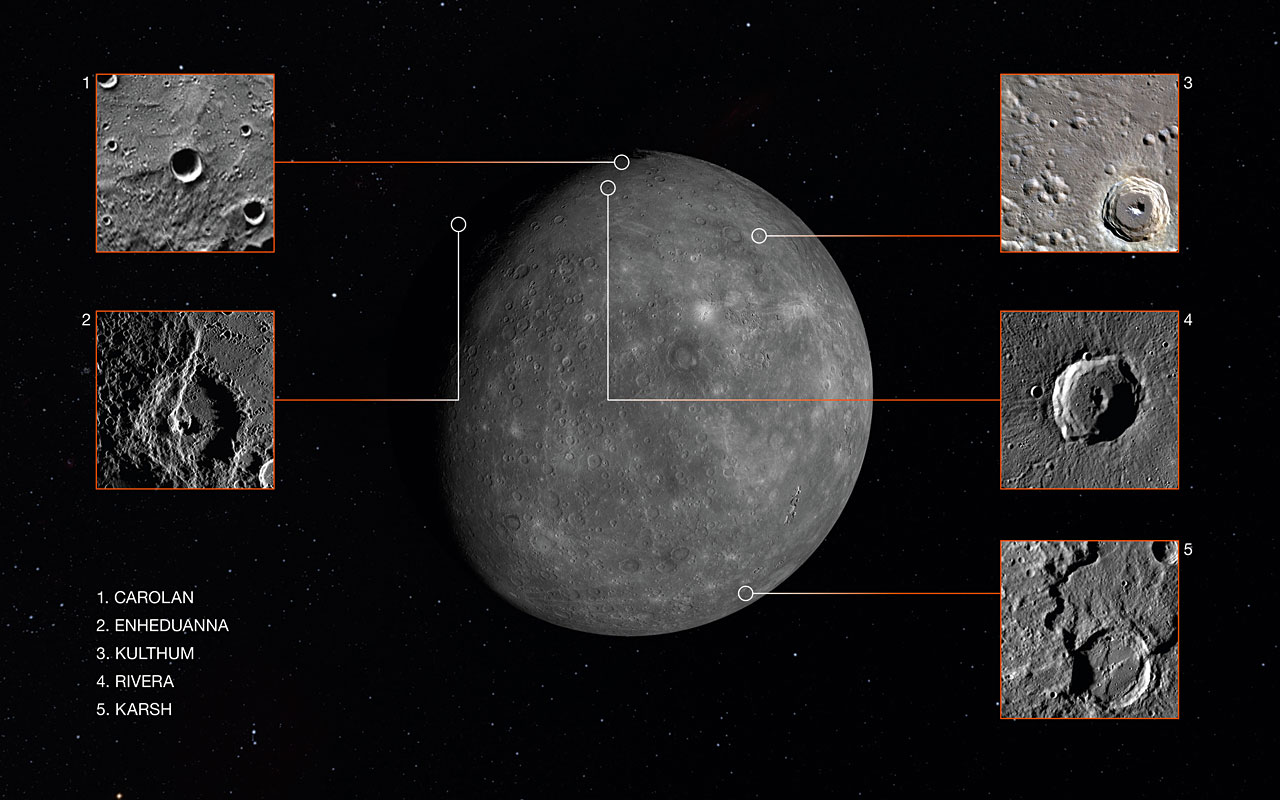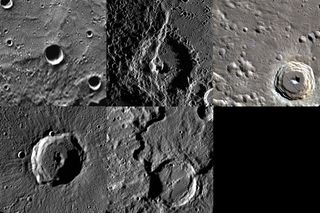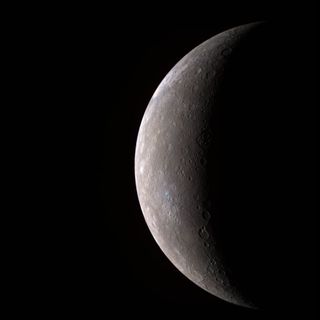Five Mercury Craters Named to Celebrate End of NASA's MESSENGER Mission

Just hours before NASA's MESSENGER spacecraft was expected to crash onto the surface of Mercury, ending the probe's four-year observation of the rocky planet, the winners of a contest to name five new craters on Mercury were announced.
The five winning crater names are: Carolan, Enheduanna, Karsh, Kulthum and Rivera. The names were selected by the public outreach team for the spacecraft out of thousands of submissions to an open competition that closed in January. MESSENGER, which captured stunning images of Mercury's cratered surface, crashed into the surface of the planet at at 3:26 p.m. EDT (1926 GMT) yesterday (April 30).
The new crater names have been approved by the International Astronomical Union (IAU). The rules of the IAU state that Mercury features must be named after an artist, composer or writer who was famous for more than 50 years and died at least three years ago. [Farewell, MESSENGER! NASA Probe Crashes Into Mercury]

The selection came from more than 3,600 initial submissions and a semifinal list of 17 names. Anyone in the world could make entries, up to Jan. 15. These are the people who the craters were named after and the people who submitted those names:
- Turlough O'Carolan was an Irish composer in the late 16th and early 17th centuries. The name was suggested by Fergal Donnelly (Belguim), Joseph Brusseau (United States) and Deane Morrison (United States).
- Enheduanna, a princess of the Sumerian city of Ur in ancient Mesopotamia (modern Iraq and Kuwait), is the first known poet and author. The name was suggested by Gagan Toor (India).
- Yousuf Karsh, an Armenian-Canadian, was a famous portrait photographer in the 20th century. Elizabeth Freeman Rosenzweig (United States).
- Umm Kulthum, an Egyptian singer, songwriter and film actress, who was known for her work between the 1920s and the 1970s. The name was suggested by Molouk Ba-Isa (Saudi Arabia), Riana Rakotoarimanana (Switzerland), Yehya Hassouna (United States), David Suttles (United States), Thorayya Said Giovannelli (United States) and Matt Giovannelli (United States).
- Diego Rivera, a Mexican painter and muralist, who was active between the 1920s and 1950s. The name was suggested by Ricardo Martinez (Mexico), Rebecca Hare (United States), Arturo Gutierrez (Mexico) and José Martinez (United States).

NASA held another crater naming contest for Mercury, in 2013.
MESSENGER launched in 2004 and made three flybys of Mercury before settling into orbit around the planet in March 2011. The spacecraft crashed into the surface of Mercury at 3:26 p.m. EDT (1926 GMT) yesterday (April 30). The 10-foot-wide (3 meters) spacecraft was traveling at about 8,750 mph (14,080 km/h), and likely produced a crater about 52 feet (16 m) across.
Get the Space.com Newsletter
Breaking space news, the latest updates on rocket launches, skywatching events and more!
Among MESSENGER's achievements were finding water ice in permanently shadowed craters, organics on the surface and details about Mercury's magnetic field. The craft also took 250,000 pictures, far surpassing the 2,500 originally forecast.
Follow Elizabeth Howell @howellspace, or Space.com @Spacedotcom. We're also on Facebook and Google+. Originally published on Space.com.
Join our Space Forums to keep talking space on the latest missions, night sky and more! And if you have a news tip, correction or comment, let us know at: community@space.com.

Elizabeth Howell (she/her), Ph.D., is a staff writer in the spaceflight channel since 2022 covering diversity, education and gaming as well. She was contributing writer for Space.com for 10 years before joining full-time. Elizabeth's reporting includes multiple exclusives with the White House and Office of the Vice-President of the United States, an exclusive conversation with aspiring space tourist (and NSYNC bassist) Lance Bass, speaking several times with the International Space Station, witnessing five human spaceflight launches on two continents, flying parabolic, working inside a spacesuit, and participating in a simulated Mars mission. Her latest book, "Why Am I Taller?", is co-written with astronaut Dave Williams. Elizabeth holds a Ph.D. and M.Sc. in Space Studies from the University of North Dakota, a Bachelor of Journalism from Canada's Carleton University and a Bachelor of History from Canada's Athabasca University. Elizabeth is also a post-secondary instructor in communications and science at several institutions since 2015; her experience includes developing and teaching an astronomy course at Canada's Algonquin College (with Indigenous content as well) to more than 1,000 students since 2020. Elizabeth first got interested in space after watching the movie Apollo 13 in 1996, and still wants to be an astronaut someday. Mastodon: https://qoto.org/@howellspace